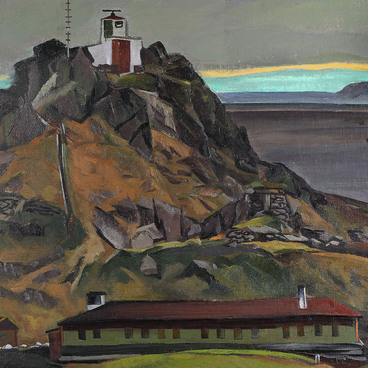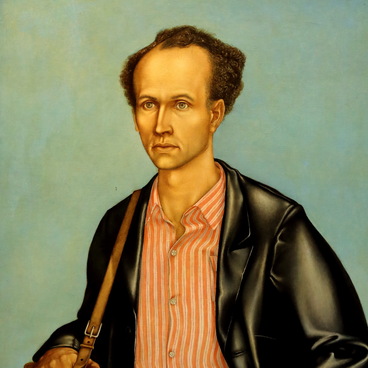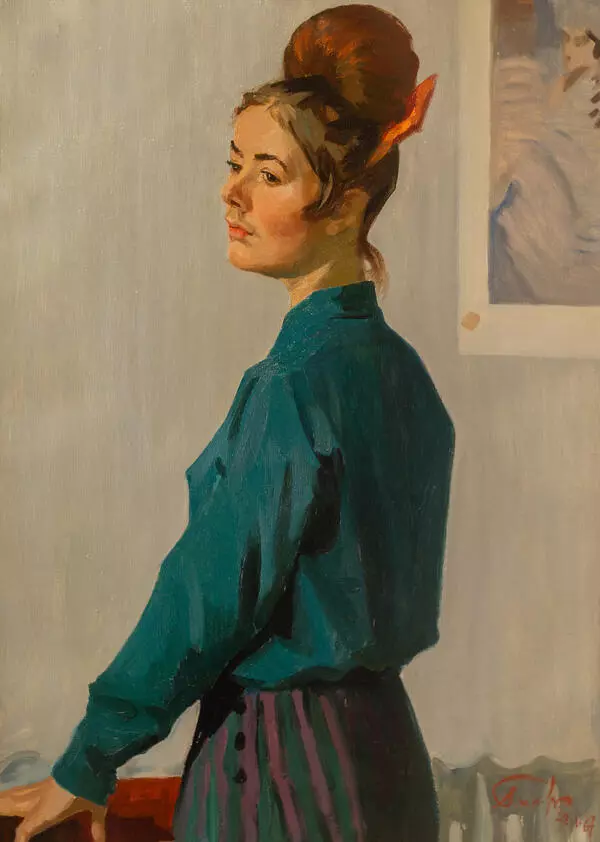“Vladimir Lenin in Gorki” is a portrait painted by the Ural artist Gennady Gayev in 1971.
Socialist realism in Soviet art was inextricably connected with the themes of history and revolution, where the image of the leader Vladimir Ilyich Lenin quite obviously occupied a special place. Ural artists were also engaged in creating artworks in this genre: apart from their usual characteristic paintings, they were also commissioned to paint generic works for public holidays.
In the 1970s, the Ural works in the “Leniniana” genre were still on the rise, and nowadays the museum houses one of its examples. In his works, Gennady Gayev repeatedly addressed the subject of the Great October Revolution and the image of its ideological inspirer. It is no wonder that, among other museum collections, Gayev’s paintings were included in the collection of the Museum of the Revolution in Moscow (now known as the Museum of Contemporary History of Russia).
According to one of the traditional compositions of the genre, the canvas depicts the ideologist and founder of the Soviet state at work. Lenin is engaged in telephone conversations in a certain room of the Gorki estate, now part of the State Museum-Reserve “Gorki Leninskiye”.
This estate located in the Moscow region was well-known to every Soviet citizen because Vladimir Lenin lived there from 1921 to 1924. That same fact helped the estate to escape the ruin and destruction that many homes of the gentry were subjected to. Throughout the Soviet period, no changes were made either in the exterior or interior design of the estate: it had been left untouched since the early 20th century when it was rebuilt by the famous architect Fyodor Schechtel. “Gorki Leninskiye” is one of the few estates in Russia that has preserved its interiors, adornments, and relics.
The artist rendered the atmosphere of Lenin’s office with wall-mounted telephones and chairs in red striped covers. The availability of a telephone played an important role in the choice of Gorki as the place for Lenin’s residence. Despite the poor connection, it was still possible to send telegrams and make calls from the estate. The current museum located in the estate has kept the telephone room with old L. M. Ericsson & Co telephones intact.
Gennady Gayev uses the interiors of this room to portray Lenin. The leader’s arm in a sling alludes to the injury he sustained in August 1918. Vladimir Lenin stayed in Gorki to restore his health after being wounded.
Socialist realism in Soviet art was inextricably connected with the themes of history and revolution, where the image of the leader Vladimir Ilyich Lenin quite obviously occupied a special place. Ural artists were also engaged in creating artworks in this genre: apart from their usual characteristic paintings, they were also commissioned to paint generic works for public holidays.
In the 1970s, the Ural works in the “Leniniana” genre were still on the rise, and nowadays the museum houses one of its examples. In his works, Gennady Gayev repeatedly addressed the subject of the Great October Revolution and the image of its ideological inspirer. It is no wonder that, among other museum collections, Gayev’s paintings were included in the collection of the Museum of the Revolution in Moscow (now known as the Museum of Contemporary History of Russia).
According to one of the traditional compositions of the genre, the canvas depicts the ideologist and founder of the Soviet state at work. Lenin is engaged in telephone conversations in a certain room of the Gorki estate, now part of the State Museum-Reserve “Gorki Leninskiye”.
This estate located in the Moscow region was well-known to every Soviet citizen because Vladimir Lenin lived there from 1921 to 1924. That same fact helped the estate to escape the ruin and destruction that many homes of the gentry were subjected to. Throughout the Soviet period, no changes were made either in the exterior or interior design of the estate: it had been left untouched since the early 20th century when it was rebuilt by the famous architect Fyodor Schechtel. “Gorki Leninskiye” is one of the few estates in Russia that has preserved its interiors, adornments, and relics.
The artist rendered the atmosphere of Lenin’s office with wall-mounted telephones and chairs in red striped covers. The availability of a telephone played an important role in the choice of Gorki as the place for Lenin’s residence. Despite the poor connection, it was still possible to send telegrams and make calls from the estate. The current museum located in the estate has kept the telephone room with old L. M. Ericsson & Co telephones intact.
Gennady Gayev uses the interiors of this room to portray Lenin. The leader’s arm in a sling alludes to the injury he sustained in August 1918. Vladimir Lenin stayed in Gorki to restore his health after being wounded.
Over time, the number of Lenin’s visits to Gorki increased until he finally moved to the estate, where he died on January 21, 1924.


